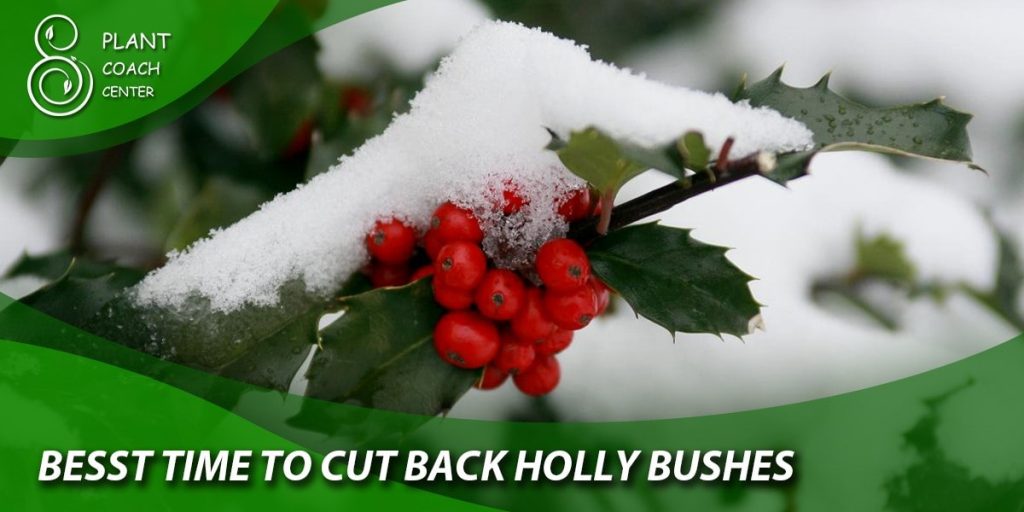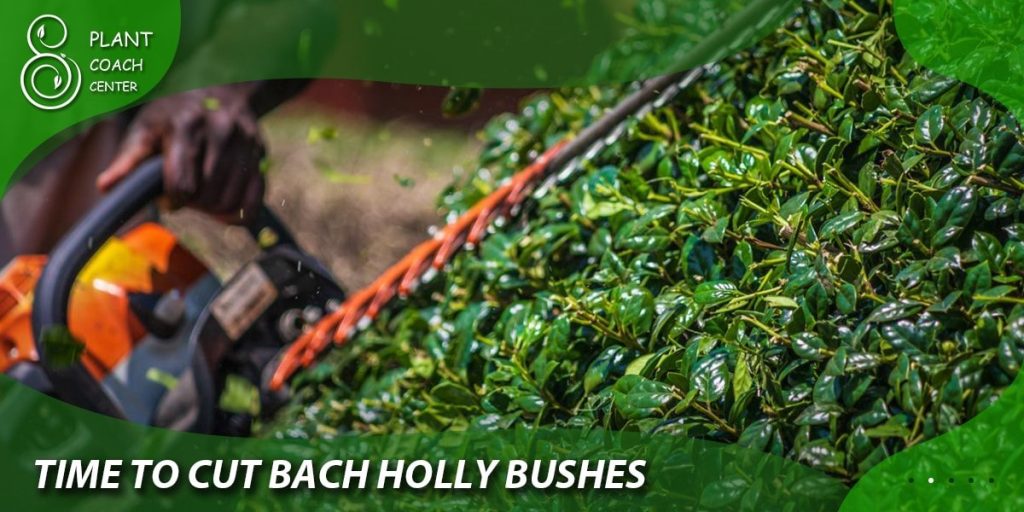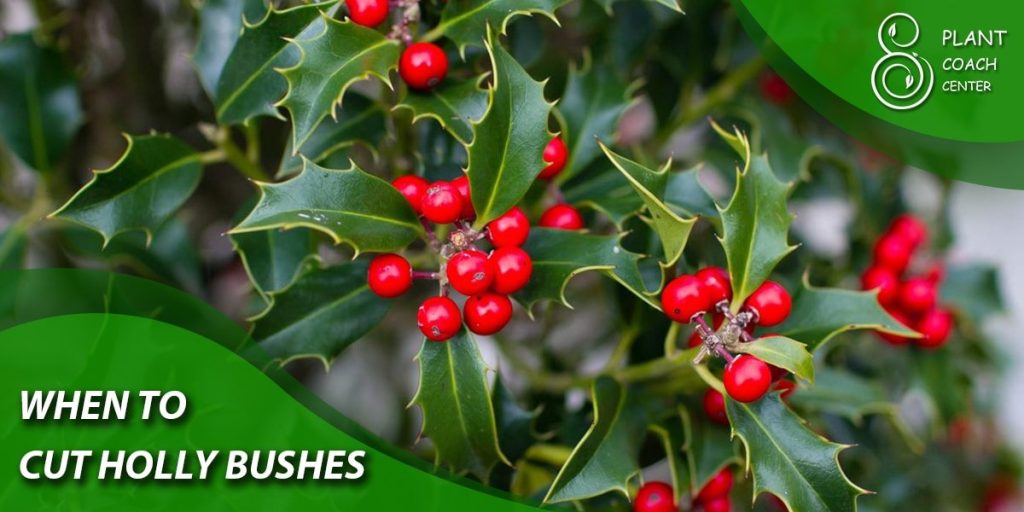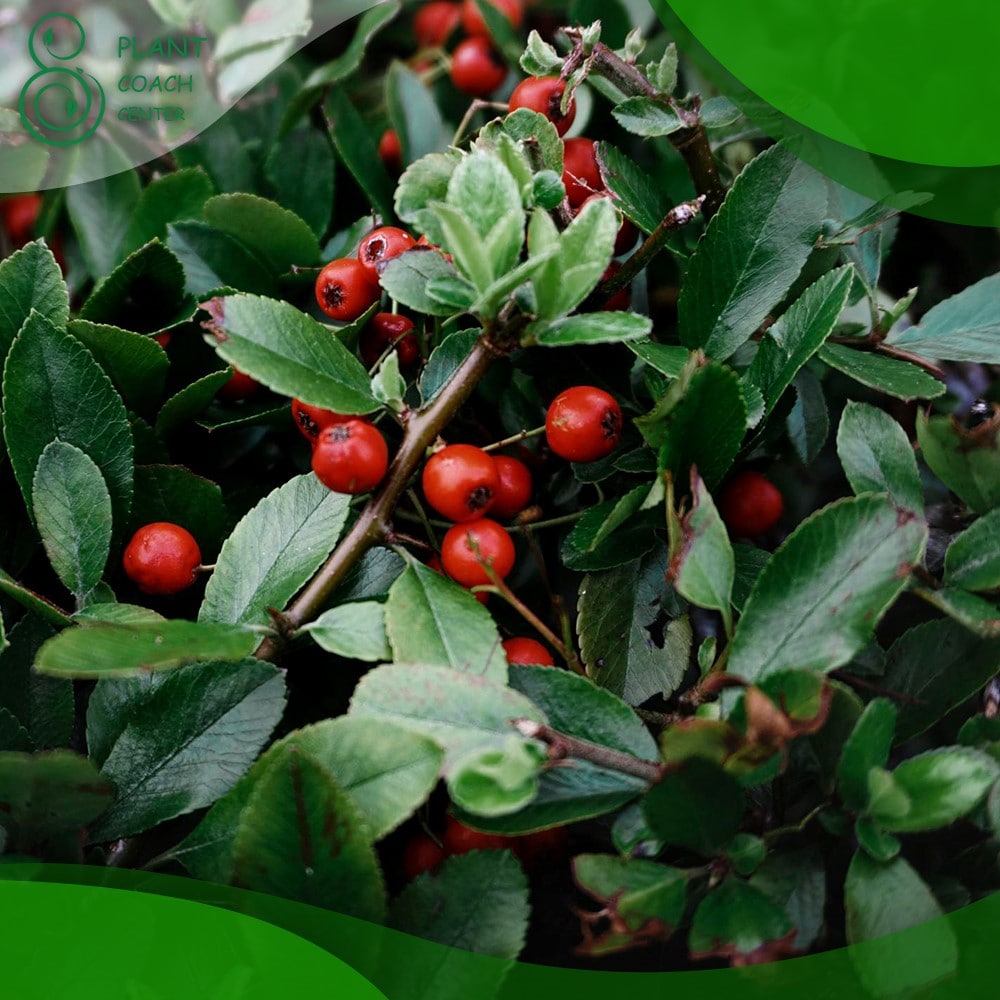When to Cut Back Holly Bushes
Holly bushes are a cherished addition to many gardens and landscapes, known for their vibrant green foliage and iconic red berries. Proper care and maintenance are crucial to the healthy and thriving of these stunning plants. One essential aspect of holly bush care is knowing when and how to prune them.
Pruning is vital in enhancing their appearance, promoting vigorous growth, and managing their size and shape. This comprehensive guide will explore the best practices for pruning holly bushes, focusing on the ideal timing for cutting back and addressing common plant problems.

Understanding Holly Bushes
Holly Bushes: An Overview
Holly bushes (Ilex spp.) are evergreen plants that belong to the Aquifoliaceae family. They encompass various species and cultivars, each with unique characteristics. These plants typically feature glossy, leathery leaves, often adorned with spiky edges. Holly bushes are valued for their ornamental appeal. They are often used for hedges, privacy screens, or as standalone focal points in gardens.
Benefits of Pruning Holly Bushes
Pruning serves as an essential horticultural practice for maintaining the health and vitality of holly bushes. Here are a few key benefits of regular pruning:
- Enhancing the Aesthetic Appeal: Pruning helps shape holly bushes, creating a well-maintained and visually pleasing appearance.
- Promoting Healthy Growth and Vigor: Removing dead or diseased branches stimulates new growth, improving the plant’s overall health.
- Managing Size and Shape: Holly bushes tend to thrive. Pruning helps control their size, preventing them from becoming overly large or unruly.
Pruning Basics
Understanding Pruning Principles:
Before diving into the process of cutting back holly bushes, it’s important to grasp some fundamental pruning principles. These principles will guide you in achieving the desired results and maintaining the health of your holly bushes.
- Importance of Proper Tools and Techniques
Using the right tools for pruning is crucial to ensure clean cuts and minimize damage to the plant. Quality hand pruners, loppers, and pruning saws are essential for different pruning tasks. Additionally, understanding the correct pruning techniques, such as heading cuts (removing a portion of a branch) and thinning cuts (removing an entire branch at its point of origin), is vital to shaping the holly bushes effectively.
Essential Pruning Tools for Holly Bushes:
To make the pruning process efficient and effective, you’ll need the following tools:
- Hand Pruners: Also known as secateurs, these are ideal for cutting small branches and stems up to ¾ inches in diameter. Look for pruners with sharp blades and comfortable handles for ease of use.
- Loppers: Designed for thicker branches, loppers have long handles and larger blades. They allow you to cut branches up to 1 ½ inches thick. Choose loppers with a bypass cutting action for cleaner cuts.
- Pruning Saw: A pruning saw is indispensable for branches larger than hand pruners or loppers can handle. Look for a saw with a curved blade and coarse teeth that can cut through thicker branches easily.
Proper maintenance of these tools is crucial for their longevity and performance. Keep them clean, sharp, and lubricated to ensure smooth cutting and prevent the transmission of diseases between plants.

Signs It’s Time to Prune
Seasonal Considerations
Knowing the ideal timing for pruning holly bushes is essential to achieve the best results. The timing can vary depending on the specific goals of pruning and the region you are located in. Let’s explore the different seasons and their respective considerations for pruning holly bushes:
Pruning in Spring:
Spring is a favorable time for pruning holly bushes, especially after the danger of frost has passed. Here are some benefits and considerations for pruning during this season:
Benefits:
- Encourages vigorous growth: Spring pruning stimulates new growth, giving holly bushes a vibrant appearance.
- Enhances berry production: Spring pruning can improve berry production during the subsequent winter months.
- Allows for shaping and maintenance: Spring pruning helps maintain the desired shape and size of the holly bushes.
Best Practices:
- Wait until the early to mid-spring to ensure the risk of frost has diminished.
- Avoid pruning too late in spring, as it may interfere with the development of flower buds for the following year.
2.Pruning in Summer:
While less common, summer pruning can be beneficial under certain circumstances. Consider the following factors when deciding to prune holly bushes during the summer:
Reasons to Prune in Summer:
- Corrective pruning: Summer is an excellent time to address any issues with the shape or size of the holly bushes.
- Removal of damaged or diseased branches: Pruning in summer allows for the prompt removal of any branches affected by disease or damage.
- Maintenance pruning: Regular summer pruning can help keep the holly bushes in check and prevent excessive growth.
Precautions:
- Avoid pruning during extremely hot periods, as it can stress the plant. Choose cooler mornings or evenings for the task.
- Be mindful of potential heat stress and water the holly bushes adequately after pruning.
- Pruning in Fall and Winter:
Pruning holly bushes during the fall and winter months requires special considerations due to the plant’s dormancy and the potential for frost damage. Take note of the following factors:
Advantages and Limitations:
- Dormancy and visibility: Pruning during the dormant season allows for better visibility of the plant’s structure, making it easier to shape the holly bushes.
- Cold weather precautions: Pruning during winter requires careful attention to frost and freezing temperatures. Take steps to protect the holly bushes during and after pruning.
In the next sub-section, we will discuss specific signs and indicators that it’s time to prune your holly bushes.
Recognizing Pruning Indicators:
Pruning should not be done indiscriminately but rather in response to specific signs or problems. Here are some common indicators that it’s time to cut back your holly bushes:
- Overgrown and Leggy Holly Bushes:
If your holly bushes have become overgrown or leggy, with sparse foliage near the base, it’s a clear sign that pruning is needed. Over time, holly bushes can lose their compact shape and develop an uneven appearance. Pruning can help rejuvenate the plants and restore their vigor.
- Disease and Pest Infestations:
Pruning can be an effective control measure when diseases or pest infestations plague holly bushes. Look out for signs of fungal infections, such as leaf spots or powdery mildew, and pests like aphids or scale insects. Pruning infected branches can help remove the source of the problem and prevent further spread.
- Damage and Deadwood:
Storms, accidents, or harsh weather conditions can cause damage to holly bushes, leading to broken or dead branches. These branches should be pruned promptly to prevent the spread of diseases and maintain the plant’s overall health. Additionally, the removal of deadwood promotes new growth and a more appealing appearance.
Step-by-Step Pruning Process

Preparation and Safety Measures
Before you begin pruning your holly bushes, it’s essential to take the following preparation steps and safety measures:
- Gather Necessary Materials:
Collect all the essential tools mentioned earlier, including hand pruners, loppers, and a pruning saw, to ensure you have everything within reach during the pruning process. Keep a bucket or tarp nearby to collect pruned branches and debris.
- Safety Precautions:
Pruning can involve sharp tools and potentially hazardous situations. Take the following safety precautions:
- Wear protective gloves, safety goggles, and sturdy footwear.
- Avoid overreaching or standing on unstable surfaces while pruning.
- Be cautious of electrical lines or other potential hazards in the vicinity.
Techniques for Pruning Holly Bushes:
- Pruning Young Holly Bushes:
When dealing with young holly bushes, it’s crucial to establish a proper framework for their future growth. Follow these steps for pruning young holly bushes:
- Selective Branch Removal: Identify any overcrowded, weak, or crossing branches and remove them to encourage a well-spaced and balanced structure.
- Heading Cuts: Use heading cuts to shape the bush and promote branching. Make cuts just above a bud or lateral branch, ensuring a clean, angled cut.
- Maintain a Central Leader: Encourage a central leader (the main vertical stem) for upright holly varieties. Remove competing leaders to maintain a dominant, central stem.
- Pruning Mature Holly Bushes:
For mature holly bushes, the primary focus is on maintenance and rejuvenation. Follow these steps when pruning mature holly bushes:
- Assess Overall Shape and Size: Step back and assess the plant’s overall shape and size. Determine if any branches need to be removed to maintain the desired form.
- Selective Pruning: Remove dead, damaged, or diseased branches first. Then, selectively prune to thin out crowded areas, improve airflow, and shape the holly bush.
- Rejuvenation Pruning: Consider more aggressive rejuvenation pruning if the holly bush has become overgrown or leggy. Remove up to one-third of the oldest stems by cutting them back to the ground or to a healthy lateral branch.
Aftercare and Maintenance
After completing the pruning process, providing proper aftercare and ongoing maintenance for your holly bushes is essential. Follow these guidelines:
- Dispose of Pruned Branches: Collect and dispose of pruned branches properly. If diseased or infested, seal them in a plastic bag and dispose of them in the trash to prevent further spread.
- Post-Pruning Care: Water the holly bushes thoroughly after pruning to help them recover and promote new growth. Consider applying a slow-release balanced fertilizer to support healthy regrowth.
- Regular Inspection: Periodically inspect the holly bushes for any signs of new disease or pest issues. Pruning can create wounds that may attract pests or pathogens.
Common Mistakes to Avoid

While pruning holly bushes can significantly benefit their health and appearance, it’s essential to be aware of common mistakes that should be avoided. By steering clear of these pitfalls, you can ensure optimal results and maintain the well-being of your holly bushes. Here are some common mistakes to watch out for:
- Improper Timing:
Pruning holly bushes at the wrong time can disrupt their natural growth cycles and potentially impact their flowering and berry production. Follow the recommended seasonal guidelines we discussed earlier to ensure you’re pruning at the appropriate time.
- Excessive Pruning:
Over-pruning can weaken the holly bushes and lead to stunted growth or vulnerability to diseases and pests. Avoid removing over one-third of the plant’s overall growth in a single pruning session. Maintaining a balance between the shape and health of the holly bushes is critical.
- Incorrect Pruning Cuts:
Using improper cutting techniques can cause unnecessary stress to the holly bushes and create slow-healing wounds. Always use clean, sharp tools and make clean cuts just above a bud or lateral branch. Avoid leaving stubs or making jagged cuts that can invite pests or diseases.
- Neglecting Sanitization:
Failure to sanitize your pruning tools between cuts or between different plants can contribute to the spread of diseases. Before moving from one holly bush to another, wipe your tools with a disinfectant or rubbing alcohol to prevent cross-contamination.
- Ignoring Safety Precautions:
Pruning can involve sharp tools and potentially hazardous situations. Neglecting safety precautions can result in injuries to yourself or damage to the holly bushes. Always wear appropriate protective gear, be mindful of your surroundings, and use caution when handling tools.
- Pruning During Extreme Weather:
Pruning holly bushes during extreme weather conditions, such as scorching heat or cold, can harm the plants. Extreme heat can stress the holly bushes while freezing temperatures can lead to damage. Plan your pruning sessions during milder weather to ensure the best outcome.
Remember, each pruning session should be approached with care and consideration for the well-being of your holly bushes. By avoiding these common mistakes, you can promote healthy growth and maintain the beauty of your holly bushes for years.
Last words
Pruning holly bushes is an essential aspect of their care and maintenance. By understanding the principles of pruning, recognize the signs indicating it’s time to prune. Following the proper techniques, you can ensure healthy and aesthetically pleasing holly bushes in your garden or landscape.
Throughout this comprehensive guide, we have explored various aspects of pruning holly bushes. We began with an overview of holly bushes and the benefits of pruning. We then discussed the importance of using the right tools and understanding pruning principles. Understanding when to prune holly bushes based on seasonal considerations and recognizing pruning indicators were also covered in detail.
We provided step-by-step instructions for the pruning process, including preparation and safety measures, techniques for pruning young and mature holly bushes, and post-pruning care. Additionally, we highlighted common mistakes to avoid to ensure successful pruning outcomes and the continued health of your holly bushes.
Remember, proper pruning enhances the appearance of holly bushes and promotes their overall vitality. Regular pruning sessions carried out with care and consideration, will help maintain the desired shape and size, control overgrowth, and address any issues such as diseases or damaged branches.
As you embark on your pruning journey, observe your holly bushes closely, adapting your practices to their specific needs. With time and experience, you will develop a deeper understanding of your holly bushes, allowing you to fine-tune your pruning techniques and achieve the best results.
So, grab your tools, put on your gloves, and venture into the art of pruning holly bushes. Enjoy shaping and caring for these beautiful plants, and witness the rewards of a well-maintained and flourishing holly bush in your garden.
When is the best time to prune holly bushes?
Spring or early summer.
How much should I prune my holly bushes?
Avoid removing more than one-third of the plant's growth.
Can I prune holly bushes in winter?
Yes, but take precautions to protect them from frost.







